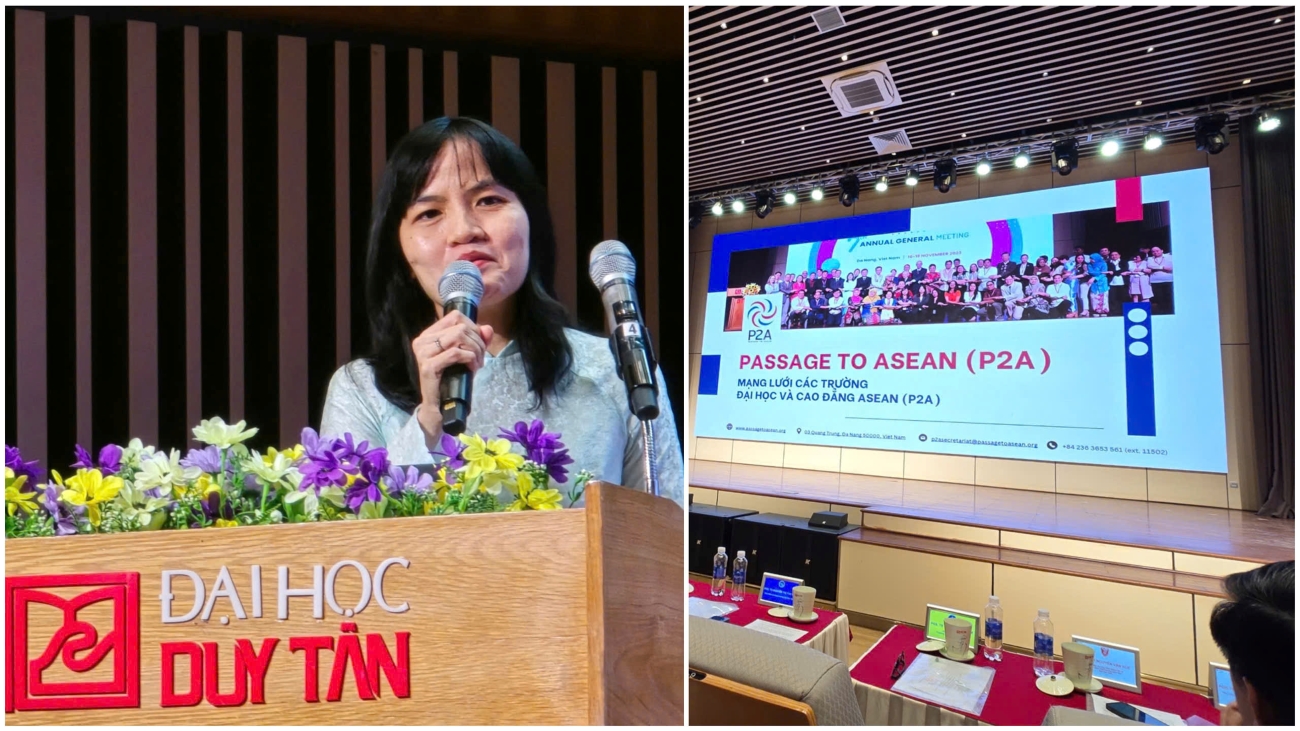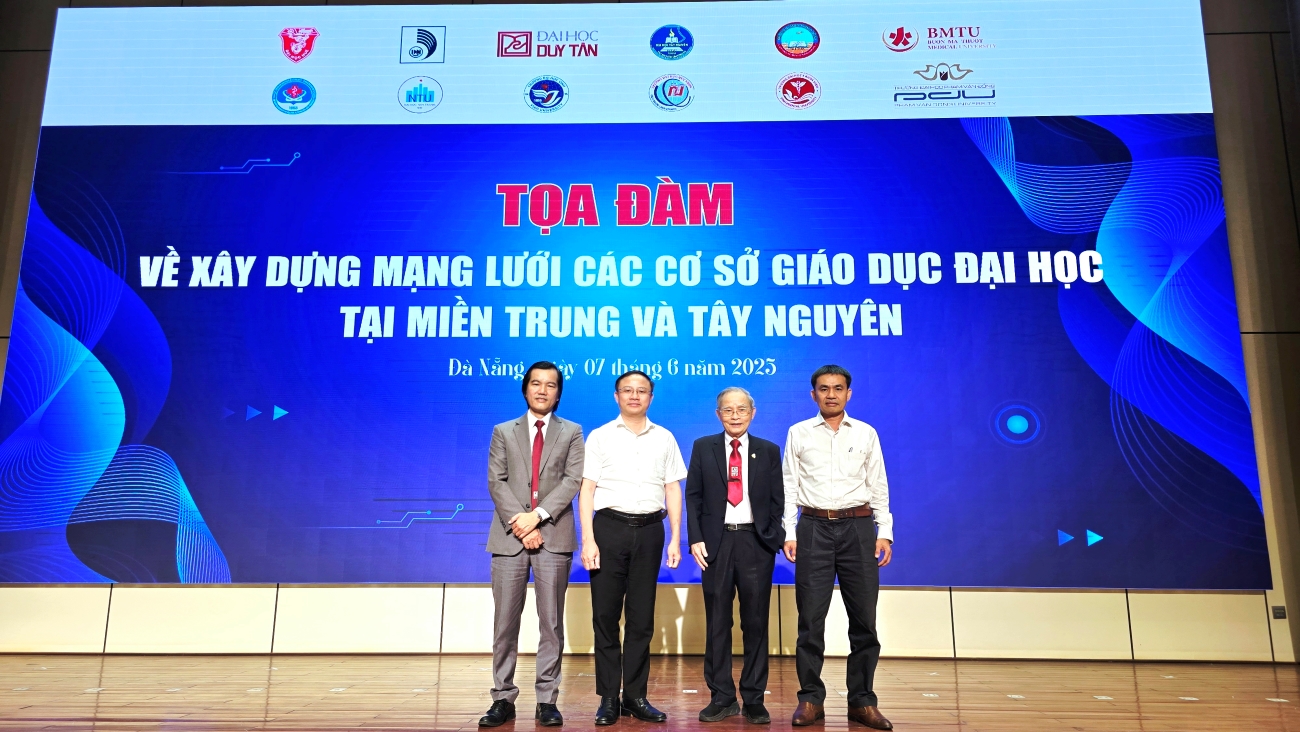DLR - On June 7, a symposium on establishing a network of higher education institutions in Central and Central Highlands Vietnam was held at the Quang Trung Campus of Duy Tan University (Da Nang). The event aimed to foster collaborative development among 12 universities and member institutions. Representing Quy Nhon University was Assoc. Prof. Dr. Doan Duc Tung, Rector of the university.
In the context of the rapidly unfolding Fourth Industrial Revolution, where Artificial Intelligence (AI) is becoming a foundational pillar across all sectors, enhancing graduates’ competitiveness is no longer a choice but a vital imperative for every higher education institution. This is especially true for the Central and Central Highlands regions of Vietnam, where localities are making strong efforts to attract investment and promote sustainable economic development. In this endeavor, AI serves as the “golden key” to unlocking the door to the future.

Assoc. Prof. Dr. Doan Duc Tung, Rector of Quy Nhon University, attended the event and delivered remarks at the symposium
At the same time, under the shared vision for 2030, the Central and Central Highlands regions are set to become leading hubs for training, research, and the application of Artificial Intelligence (AI) in Vietnam and the broader region. These areas aim to attract top talent and investment from major technology corporations, thereby contributing to sustainable socio-economic development and playing a pioneering role in international integration in science and technology.
Fully aware of this strategic importance, Duy Tan University took the lead in organizing the symposium, bringing together leaders of higher education institutions, leading experts, policymakers, and technology enterprises to engage in discussions and shape a breakthrough strategy for AI training and application.
.jpg)
People’s Teacher and Hero of Labor Le Cong Co, Chairman of the Board of Trustees of Duy Tan University, delivered the welcome speech.
Building on this shared vision and the region’s current capacities, the symposium outlined a collective mission that includes: developing a high-quality AI workforce, taking the lead in AI training and applied research to meet regional and national development needs; fostering an innovative ecosystem that enhances the competitiveness of students, faculty, and researchers; and attracting strategic investments from domestic and international private sectors to create a pioneering ecosystem for scientific and technological advancement, innovation, and national digital transformation.
The alliance of universities in Central and Central Highlands Vietnam also aims to build a regionally connected AI ecosystem, in which universities share resources, collaborate in research, training, and technology transfer—laying a solid foundation for the region to become Vietnam’s and Southeast Asia’s future “AI Hub.”

Dr. Le Van Ut (Van Lang University) presented on the topic “University Rankings: Enhancing the International Visibility of Vietnamese Universities.”The symposium was structured into three main parts: a keynote report, a series of in-depth presentations, and an open discussion session.
During the presentations, experts such as Dr. Le Nguyen Tue Hang and Assoc. Prof. Dr. Nguyen Gia Nhu (from Duy Tan University) shared solutions for developing a regionally connected AI ecosystem, highlighting the strategic foundations for establishing the Central and Central Highlands regions as an AI Hub for Vietnam and the broader Southeast Asian region.
In addition, issues related to international integration strategies through university rankings were addressed by Dr. Le Van Ut (Van Lang University) and Dr. Tran Nhat Tan (Duy Tan University), offering a sustainable direction for universities in the alliance and enhancing their global competitiveness.

Dr. Le Nguyen Tue Hang, Vice President of Duy Tan University, shared insights into the activities of the ASEAN Administrative Institute (P2A).
The symposium featured discussions centered around several key themes, including: fundamental and comprehensive reform of education and training through the integration of Artificial Intelligence—highlighting curriculum integration, innovative teaching methodologies, and faculty development; breakthroughs in science, technology, innovation, and digital transformation; encouragement and development of the private sector in the field of AI; and international integration in AI.
More than just a platform for sharing ideas, the symposium served as an open forum for delegates to engage in meaningful dialogue and propose foundational principles for the alliance’s development, as well as to outline a long-term vision for collaboration in educational innovation, science and technology, digital transformation, and global integration. With the support and engagement of stakeholders, the Central and Central Highlands AI University Alliance aspires to lead an educational revolution—where knowledge and technology go hand in hand—driving the region’s emergence as a promising hub of artificial intelligence.

Assoc. Prof. Dr. Doan Duc Tung also joined other delegates for a commemorative photo.
At the conclusion of the symposium, fueled by a spirit of collaboration, unwavering determination, and the collective will of all participating universities in the Central and Central Highlands regions, the alliance expressed strong confidence that the Joint Declaration would serve as a guiding compass—ushering in a new era for higher education, scientific research, and high-quality workforce development. Through this commitment, the alliance pledges to turn its vision into reality, positioning the Central and Central Highlands as a major center for AI advancement in Vietnam, contributing to regional sustainability and to a resilient, digitally empowered Vietnam in the years to come.
Danh sách 12 cơ sở giáo dục đại học liên minh tại khu vực miền Trung và Tây Nguyên
1. Đại học Huế;
2. Đại học Đà Nẵng;
3. Đại học Duy Tân;
4. Trường Đại học Vinh;
5. Trường Đại học Kỹ thuật Y Dược Đà Nẵng;
6. Trường Đại học Nha Trang;
7. Trường Đại học Phạm Văn Đồng;
8. Trường Đại học Quy Nhơn;
9. Trường Đại học Tây Nguyên;
10. Trường Đại học Y Dược Buôn Ma Thuột;
11. Trường Đại học Y khoa Vinh;
12. Trường Sĩ quan không quân. |
Bao Thuan - Minh Hien
Vo Thien An